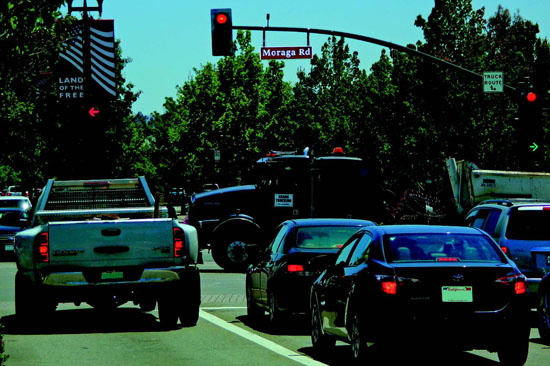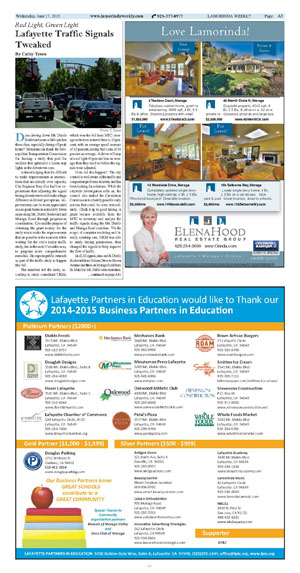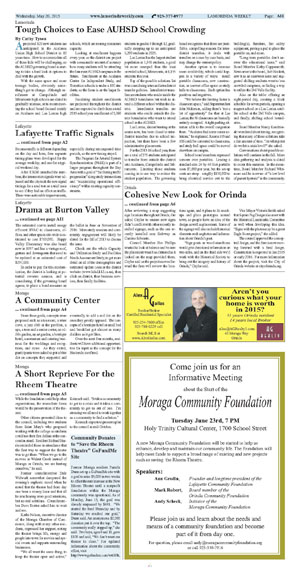|
|
Published June 17th, 2015
|
Red Light, Green Light
|
| Lafayette Traffic Signals Tweaked |
| By Cathy Tyson |
 |
| Photo C. Tyson |
Does driving down Mt. Diablo Boulevard seem a little quicker these days, especially during off-peak hours? Motorists can thank the Metropolitan Transportation Commission for funding a study that paid for analysis that optimized a dozen stop lights in the downtown core.
 Acknowledging that it's difficult to make improvements at intersections that are already over capacity, City Engineer Tony Coe had low expectations that adjusting the signal timing downtown would make a huge difference in drivers' perceptions. Improvements can be most appreciated at non-peak hours in noticeably fewer stops along Mt. Diablo Boulevard and Moraga Road through progression coordination. Coe said the purpose of obtaining the grant money for the study was to make the improvements that are possible at the moment, while waiting for the city's major traffic study, due in the next 15 months or so, to pinpoint more comprehensive remedies. He expects public outreach as part of the traffic study to happen this fall.
Acknowledging that it's difficult to make improvements at intersections that are already over capacity, City Engineer Tony Coe had low expectations that adjusting the signal timing downtown would make a huge difference in drivers' perceptions. Improvements can be most appreciated at non-peak hours in noticeably fewer stops along Mt. Diablo Boulevard and Moraga Road through progression coordination. Coe said the purpose of obtaining the grant money for the study was to make the improvements that are possible at the moment, while waiting for the city's major traffic study, due in the next 15 months or so, to pinpoint more comprehensive remedies. He expects public outreach as part of the traffic study to happen this fall.
 The numbers tell the story, according to study consultant TJKM, which won the bid from MTC: average reduction in travel time is 35 percent, with an average speed increase of 62 percent, saving fuel costs of 24 percent on average. A driver will stop at a red light 45 percent less on average than they used to before the signals were adjusted.
The numbers tell the story, according to study consultant TJKM, which won the bid from MTC: average reduction in travel time is 35 percent, with an average speed increase of 62 percent, saving fuel costs of 24 percent on average. A driver will stop at a red light 45 percent less on average than they used to before the signals were adjusted.
 How did this happen? The city council is well aware of the traffic and congestion problems in town, and has been looking for solutions. While the citywide investigation rolls on, the council also tasked the Circulation Commission to identify possible early actions that could be done immediately. Chalk it up to good timing. A grant became available from the MTC to inventory and analyze the traffic signals along the Mt. Diablo and Moraga Road corridors. Via the magic of computer modeling and literally counting cars, TJKM was able to study timing parameters, then changed the signals to help improve the flow of traffic.
How did this happen? The city council is well aware of the traffic and congestion problems in town, and has been looking for solutions. While the citywide investigation rolls on, the council also tasked the Circulation Commission to identify possible early actions that could be done immediately. Chalk it up to good timing. A grant became available from the MTC to inventory and analyze the traffic signals along the Mt. Diablo and Moraga Road corridors. Via the magic of computer modeling and literally counting cars, TJKM was able to study timing parameters, then changed the signals to help improve the flow of traffic.
 In all, 12 signals, nine on Mt. Diablo Boulevard from Dolores Drive to Brown Avenue and three on Moraga Road from St. Mary's to Mt. Diablo were examined. Because traffic is different depending on the day and hour, four separate timing plans were developed for the average weekday, and one for a typical weekend day.
In all, 12 signals, nine on Mt. Diablo Boulevard from Dolores Drive to Brown Avenue and three on Moraga Road from St. Mary's to Mt. Diablo were examined. Because traffic is different depending on the day and hour, four separate timing plans were developed for the average weekday, and one for a typical weekend day.
 After TJKM crunched the numbers, the intersection signals were adjusted and the city took the new signal timings for a road test on a trial basis to see if they had an effect on traffic. There were noticeable improvements, especially during uncongested time periods, so the new timing stayed.
After TJKM crunched the numbers, the intersection signals were adjusted and the city took the new signal timings for a road test on a trial basis to see if they had an effect on traffic. There were noticeable improvements, especially during uncongested time periods, so the new timing stayed.
 The Program for Arterial System Synchronization (PASS) is part of a larger program throughout the Bay Area with a goal of "facilitating traffic progression" along study intersections and "maximizing operational efficiency" within existing capacity constraints.
The Program for Arterial System Synchronization (PASS) is part of a larger program throughout the Bay Area with a goal of "facilitating traffic progression" along study intersections and "maximizing operational efficiency" within existing capacity constraints.

|
|
|
|
|
|
|
|
|
| |
|
|
|
|




